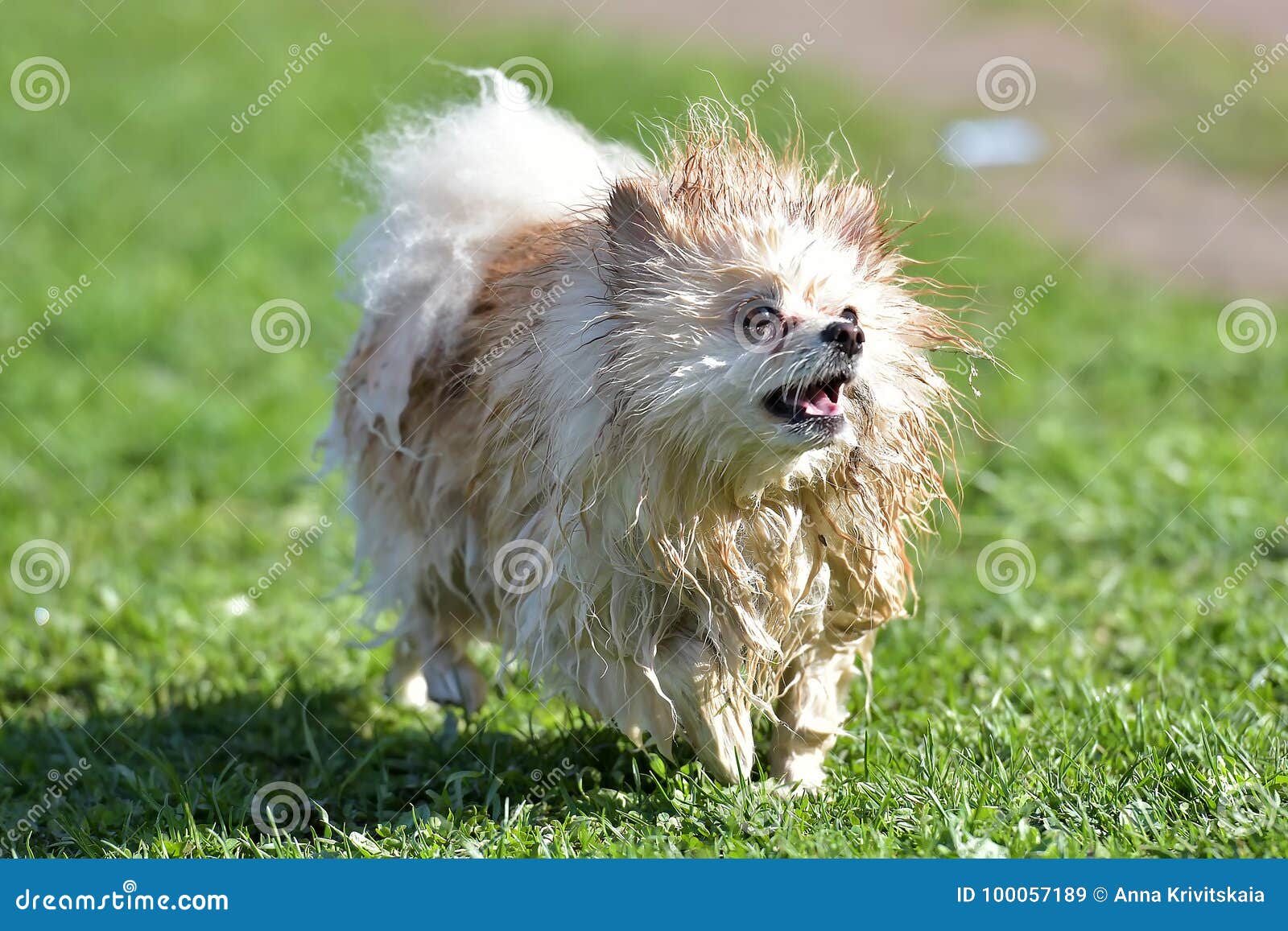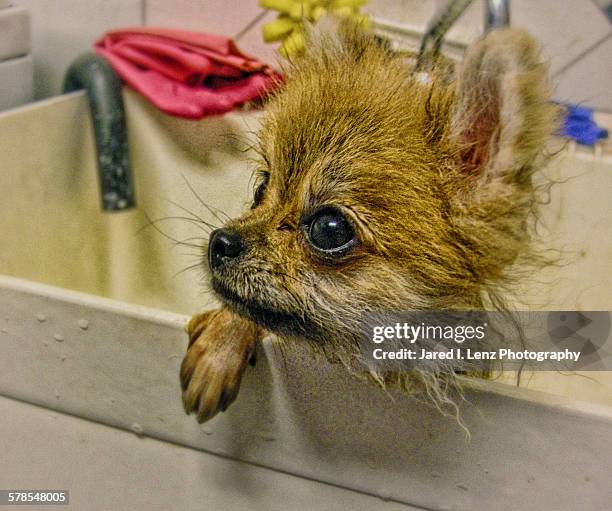Wet Pomeranian: A Comprehensive Guide To Caring For Your Fluffy Companion
When it comes to caring for a wet Pomeranian, there are many important factors to consider. Pomeranians are small, fluffy dogs with thick double coats that require proper attention after getting wet. Whether your Pomeranian has been playing in the rain or just finished a bath, it's essential to understand the correct techniques and precautions to ensure their comfort and health.
As a responsible pet owner, it's crucial to be aware of the potential risks associated with a wet Pomeranian, such as hypothermia, skin irritation, and coat damage. In this article, we will explore everything you need to know about drying and caring for your Pomeranian after they get wet, ensuring they remain happy and healthy.
By following the tips and guidelines provided in this article, you will learn how to properly care for your Pomeranian's coat, maintain their hygiene, and prevent any potential health issues. Let's dive into the world of Pomeranian care and discover how to keep your furry friend in top condition.
Read also:What Happened To Roblox In 2024 A Comprehensive Analysis
Table of Contents
- Understanding Pomeranian Coat Biology
- Potential Risks of a Wet Pomeranian
- Best Practices for Drying a Wet Pomeranian
- Essential Tools for Drying
- Proper Bathing Techniques for Pomeranians
- Seasonal Care for Wet Pomeranians
- Preventing Wetness in Pomeranians
- Health Considerations for Wet Pomeranians
- Additional Tips for Pomeranian Owners
- Conclusion and Final Thoughts
Understanding Pomeranian Coat Biology
Pomeranians are known for their luxurious, fluffy coats, which consist of two layers: an outer coat and an undercoat. The outer coat is long, straight, and coarse, while the undercoat is soft and dense. This double coat serves as insulation, protecting the dog from both cold and heat. However, when a Pomeranian gets wet, the coat can become heavy and take longer to dry, which may lead to discomfort or health issues.
Why Pomeranian Coats Take Longer to Dry
Due to their thick double coats, Pomeranians require extra attention when drying. The dense undercoat can trap moisture, creating a breeding ground for bacteria and fungi if not properly dried. Additionally, the long outer coat can mat when wet, leading to discomfort and potential skin irritation.
Potential Risks of a Wet Pomeranian
Leaving your Pomeranian wet for an extended period can pose several risks to their health and well-being. It's important to understand these risks to ensure your furry friend stays safe and comfortable.
Risk of Hypothermia
Hypothermia is a serious condition that can occur when a Pomeranian's body temperature drops too low due to prolonged exposure to cold, wet conditions. Small dogs like Pomeranians are particularly vulnerable to hypothermia because of their size and limited body fat.
Skin Irritation and Infections
Moisture trapped in the coat can cause skin irritation and infections. Fungi and bacteria thrive in damp environments, which can lead to conditions such as hot spots or dermatitis. Regularly checking your Pomeranian's skin for signs of irritation is essential for early detection and treatment.
Best Practices for Drying a Wet Pomeranian
Drying your Pomeranian properly is crucial for their health and comfort. Follow these best practices to ensure your furry friend dries quickly and safely:
Read also:Rizzler Song Tiktok Unveiling The Phenomenon Thats Taking The World By Storm
- Use a soft, absorbent towel to gently pat your Pomeranian dry after a bath or exposure to water.
- Avoid rubbing the coat vigorously, as this can cause matting and discomfort.
- Focus on drying the undercoat thoroughly, as this is where moisture can become trapped.
Using a Hairdryer Safely
While hairdryers can be effective for drying Pomeranians, it's important to use them safely. Set the dryer to a low heat setting and maintain a safe distance from your dog's skin to prevent burns. Always monitor your Pomeranian closely while using a hairdryer.
Essential Tools for Drying
Having the right tools can make the drying process easier and more effective. Consider investing in the following items:
- A high-quality, pet-safe hairdryer with adjustable heat settings.
- A soft, absorbent towel specifically designed for drying pets.
- A slicker brush to help detangle the coat and remove any mats caused by moisture.
Proper Bathing Techniques for Pomeranians
Bathing your Pomeranian correctly is essential for maintaining their hygiene and coat health. Follow these steps for a successful bathing experience:
Choosing the Right Shampoo
Use a high-quality, dog-specific shampoo that is gentle on your Pomeranian's skin and coat. Avoid human shampoos, as they can strip the coat of its natural oils and cause irritation.
Drying After Bathing
After bathing, thoroughly dry your Pomeranian using the techniques outlined earlier. Pay special attention to the undercoat and any areas where moisture can become trapped, such as the ears and paws.
Seasonal Care for Wet Pomeranians
Seasonal changes can affect how you care for your wet Pomeranian. During colder months, it's especially important to dry your dog promptly to prevent hypothermia. In warmer months, focus on preventing heat-related issues by ensuring your Pomeranian stays cool and hydrated.
Winter Care Tips
In winter, consider using a sweater or jacket to keep your Pomeranian warm after they get wet. This extra layer of insulation can help prevent heat loss and keep them comfortable.
Preventing Wetness in Pomeranians
Preventing your Pomeranian from getting wet in the first place can save you time and effort. Here are some tips for keeping your furry friend dry:
- Avoid walking your Pomeranian in rainy or snowy conditions without proper protection, such as a raincoat.
- Use a waterproof dog bed to prevent moisture from reaching your dog's skin during outdoor activities.
- Keep a supply of dry towels and grooming tools handy for quick drying sessions.
Health Considerations for Wet Pomeranians
Regularly monitoring your Pomeranian's health is essential for catching any issues related to moisture early. Keep an eye out for signs of skin irritation, infection, or hypothermia, and consult your veterinarian if you notice any concerning symptoms.
Signs of Skin Infections
Common signs of skin infections in Pomeranians include redness, itching, hair loss, and a foul odor. If you notice any of these symptoms, seek veterinary care promptly to address the issue.
Additional Tips for Pomeranian Owners
Here are some additional tips for caring for your wet Pomeranian:
- Establish a regular grooming routine to keep your Pomeranian's coat healthy and free of mats.
- Use positive reinforcement, such as treats and praise, to make the drying process enjoyable for your dog.
- Stay informed about Pomeranian care by consulting reputable sources and veterinary professionals.
Conclusion and Final Thoughts
Caring for a wet Pomeranian requires attention to detail and a commitment to their health and well-being. By understanding the biology of their coat, recognizing potential risks, and following proper drying techniques, you can ensure your furry friend remains happy and healthy. Remember to consult trusted sources and veterinary professionals for additional guidance on Pomeranian care.
We encourage you to share this article with fellow Pomeranian owners and leave a comment below with your thoughts or questions. For more information on Pomeranian care, explore our other articles on the site. Together, we can create a supportive community of pet lovers dedicated to the well-being of our beloved Pomeranians.
Data Sources: ASPCA, American Kennel Club, UC Davis Veterinary Medicine.


